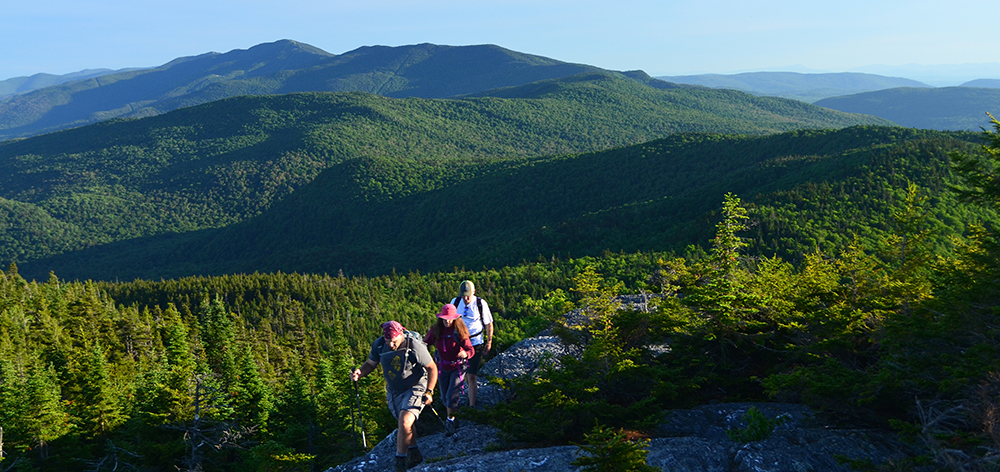Value of the great outdoors

Consider the pleasure of being on a Vermont trail: Long Trail, VAST, Catamount, Town Link Trail or Charlotte Park and Wildlife Refuge, Burlington Bike Path. There’s the beauty, relaxation, wildlife and fresh air. There is also an economic value. How do we calculate the value of outdoor recreation to the State of Vermont? And how can we help to maintain these assets?
Economic value
The Vermont Outdoor Recreation Economic Collaborative (VOREC) includes members from Vermont outdoor-related businesses, manufacturers and retailers; conservation and user groups; and state and local government. Recreation generally and trails specifically are assets that attract both residents and tourist dollars. Outdoor recreation and trails can be anchors of a community—think Sugarbush, Smugglers’ Notch and Kingdom Trails.
In Vermont, recreation accounts for $2.5 billion in consumer spending. The networks of just four trail organizations—Vermont ATV Sportsman’s Association (ATVs), Green Mountain Club (hiking), Catamount Trail Association (backcountry skiing), and Kingdom Trails Association (mountain biking)—generate more than $30 million in economic activity annually. Nationally, the Outdoor Industry Association estimates that outdoor recreation contributes $734 billion to gross domestic product.
Vermont’s outdoor recreation resources have been built and maintained largely by local communities, i.e., Town Link Trail; volunteers, i.e., The Long Trail; and nonprofit organizations, i.e., Vermont Land Trust and The Nature Conservancy.
“Volunteers and nonprofits alone aren’t enough to support Vermont’s growing outdoor infrastructure,” says Mike Debonis, executive director of the Green Mountain Club. He adds, “We measure what we treasure. The more that we are able to quantify the value and economic impact of organized outdoor recreation, the better able we will be to develop policies and funding mechanisms to support these resources.”
“Governor Phil Scott created VOREC and charged it with finding ways to inspire economic prosperity through growing and sustaining our vast outdoor recreation assets,” says Michael Snyder, commissioner of Forests, Parks and Recreation and chair of the VOREC Steering Committee. The Scott Administration proposed and the Legislature passed Act 194 that will award grants, ranging from $10,000 to $100,000, to Vermont towns to support development of “outdoor, recreation-friendly” communities.
The goal of the program is to grow outdoor recreation businesses, increase participation in outdoor recreation activities, strengthen the quality and extent of outdoor recreation resources, and increase stewardship of same.
Stewardship
With spring just around the corner (we hope), volunteer opportunities will soon abound in the outdoors as will occasions for expanding knowledge and conservation of our resources.
Friday, May 3, tree planting day at Raven Ridge in Charlotte, Hinesburg and Monkton.
The Nature Conservancy hosts a variety of volunteer opportunities in Vermont from April to November. Projects range from invasive-plant removal, building simple structures on trails or planting trees on its 55 natural areas. Keep at lookout for work days in Williams Woods as well.
Getting the Most from Your Vegetable Garden. Wednesday, March 13, 7:00 p.m. to 8:30 p.m. at the Charlotte Library. A master gardener will impart knowledge about increasing garden productivity, thoughtful design and layout, companion planting, soil care and extending the season. Beginners and experienced gardeners welcome.
Vermont Center on EcoStudies (VCE) coordinates more than a dozen projects for citizen scientists monitoring and counting birds, loons, butterflies, vernal pools and other natural features. Volunteer vernal pool monitors are poised to count egg masses of wood frogs and salamanders, record courtship croaks of wood frogs, and monitor the temperature and depth of the water. VCE provides support, equipment and training.
Keep an eye on the Town of Charlotte website and The Charlotte News. Charlotte Park and Wildlife Refuge volunteers hold work days for both planting and ridding the park of invasives. The Trail Committee hosts work days on the Town Link Trail. Charlotte Tree Deputy Warden Sue Smith organizes teams that paddle the waters of Town Farm Bay, near the mouth of Thorp Brook, on summer days, removing frogbit before it goes to seed. Point Bay Marina provides a float for the safe composting of these invasive weeds.
Seed Saving under the guidance of Linda Hamilton. The Charlotte Library is home to a seed library for heirloom vegetables. Check the library website and The Charlotte News for activities.
Spring will soon be upon us. Be ready to enjoy and support our great outdoors!

